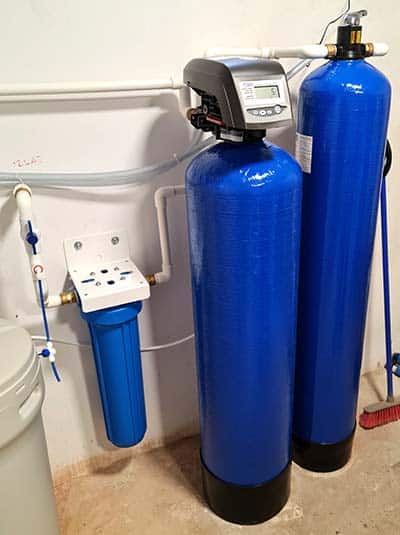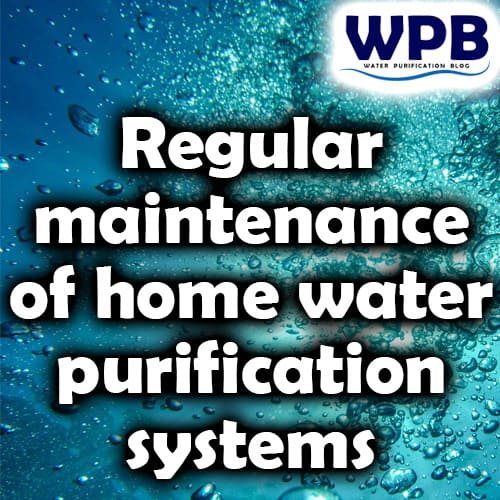Home water purification systems play a crucial role in ensuring clean and safe water.
These systems are designed to filter out impurities and various contaminants, providing high-quality drinking water.
However, like any other appliance or equipment, water purification systems require regular maintenance to function effectively and maintain their longevity.
Table of Contents
1. Home Water Purification Systems
Home water purification systems, such as whole house water filters, are designed to remove contaminants, sediments, and impurities from the water supply.
These systems consist of various filtration stages, including sediment filters, carbon filters, water softeners and reverse osmosis systems.
While they are very effective in purifying water, regular maintenance is essential to ensure their continued efficiency, effectiveness, and reliability.

2. Replacing the Filters
One of the most critical maintenance tasks for water purification systems is replacing the filters.
Filters have a specific lifespan and need to be changed periodically to maintain their functionality.
Most whole house systems have multiple filter stages, and each filter may have a different replacement frequency.
Generally, filters should be replaced once or twice a year, depending on their lifespan and usage.
To replace the water filters in your whole house system, follow these general steps:
- Shut off the water supply and open a faucet to relieve pressure and drain the water.
- If your system has a pressure release button, press it to release any remaining pressure.
- Untwist the filter housing and remove the old filter cartridge.
- Clean the filter housing if necessary.
- Dispose of the old filter and replace it with a new filter cartridge.
- Screw the filter housing back onto the system.
3. Cleaning the Filters
Certain types of filters, such as ceramic filters and spin-down sediment filters, can be cleaned and reused.
However, it’s essential to follow the manufacturer’s instructions to clean these filters properly.
On the other hand, filters like carbon filter cartridges are not designed for cleaning and should be replaced when their lifespan is over.
Attempting to clean and reuse such filters can lead to damage and ineffective filtration.
4. Cleaning the Filter Housings
Cleaning the filter housings is an important maintenance task that should be performed at least once a year or whenever you replace a water filter.
Over time, filter housings can accumulate sediment and debris, affecting the flow of water and overall system performance.
Cleaning the filter housings will help maintain optimal filtration and prevent clogs.
To clean the filter housings in a whole house water filter system, follow these general steps:
- Shut off the water supply and open a faucet to relieve pressure.
- Unscrew the filter housings.
- Fill a bowl with warm, soapy water.
- Remove the filter cartridges and place them safely aside.
- Soak the filter housings in the warm, soapy water for 5-10 minutes.
- Use a sponge to wipe down the insides of the housings, ensuring all sediment and debris are removed.
- Thoroughly dry the housings or allow them to air-dry.
- Return the filter cartridges to their positions in the housings.
- Screw the filter housings back onto the system securely.
5. Sanitizing the Filter Housings (Optional)
In some cases, simply cleaning the filter housings may not be sufficient to ensure they are completely clean and free from bacteria.
It is recommended to sanitize the filter housings once every 1-2 years to give the entire system a deep clean.
This helps eliminate any bacteria and maintain optimal water quality.
To sanitize the filter housings, follow these steps:
- Prepare a sanitizing solution by mixing a mild bleach solution or a hydrogen peroxide solution with water.
- Unscrew the filter housings from the system.
- Immerse the filter housings in the sanitizing solution.
- Allow them to soak for the recommended time, usually 15-30 minutes.
- After soaking, rinse the filter housings thoroughly with clean water.
- Dry the housings completely before reattaching the filter cartridges and screwing them back onto the system.
6. Inspecting and Testing Home Purification Systems
Regular inspections and testing are crucial to ensure the overall performance of your water purification system.
It’s essential to check for any signs of leaks, damage, or malfunctions. Inspect all connections, valves, and fittings to ensure they are tight and secure.
Test the water flow and pressure to verify that the system is functioning optimally.
7. Checking for Leaks and Damage
Leaks can compromise the effectiveness of a water purification system and lead to water wastage. Regularly check for any signs of leaks, such as water puddles or dampness around the system.
If you notice any leaks or damage, promptly address them to prevent further issues.
8. Flushing the System
Flushing the system helps remove any accumulated sediment, debris, or stagnant water from the pipes and filters.
It is recommended to flush the system periodically, especially after filter replacements or prolonged periods of non-use.
Follow the manufacturer’s instructions on how to properly flush your specific water purification system.
9. Maintenance Before Extended Periods of Non-Use
If you plan to leave your home for an extended period, such as a vacation or seasonal closure, it is essential to perform maintenance tasks before turning off the water supply to your water purification system.
This includes replacing the filters, flushing the system, and ensuring all components are clean and in good condition.
Proper maintenance before non-use helps prevent bacteria growth and ensures the system functions optimally when you return.
10. Ensuring Proper Storage
If you need to store your water purification system temporarily, make sure to follow the manufacturer’s guidelines for proper storage.
This may include draining the system, removing filters, and storing them in a clean and dry environment.
Proper storage helps prevent damage to the system and ensures its longevity.
11. The Benefits of Regular Maintenance
Regular maintenance of home water purification systems offers several benefits:
Consistent Water Quality: By regularly replacing filters and cleaning the system, you can ensure that your water purification system continues to deliver high-quality, purified water.
Extended Lifespan: Proper maintenance helps prevent clogs, damage, and malfunctions, extending the lifespan of your water purification system.
Cost Savings: Regular maintenance of home water purification systems reduces the need for costly repairs and replacements in the long run.
Optimal Performance: A well-maintained water purification system operates at its peak performance, providing efficient filtration and water flow.
In conclusion, regular maintenance of home water purification systems is crucial for water purification systems to ensure their optimal performance and longevity.
By following the outlined maintenance tasks and taking proactive measures, you can enjoy clean and safe water for your household.
Remember to consult the manufacturer’s instructions and seek professional assistance when needed to maintain your water purification system effectively.
FAQS: Regular maintenance of home water purification systems
- How often should I replace the filters in my water purification system?
- The frequency of filter replacement depends on the type of filters and the manufacturer’s recommendations. Generally, filters should be replaced once or twice a year.
- Can I clean and reuse all types of filters?
- No, not all filters can be cleaned and reused. Ceramic filters and spin-down sediment filters are examples of filters that can be cleaned, while carbon filter cartridges are generally not designed for cleaning and should be replaced.
- Is it necessary to sanitize the filter housings?
- Sanitizing the filter housings is optional but recommended, especially if you want to give your system a deep clean. It helps eliminate bacteria and maintain optimal water quality.
- How often should I inspect and test my water purification system?
- Regular inspections and testing should be performed to ensure the system’s overall performance. It’s recommended to conduct inspections at least once a year or whenever you notice any issues with the system.
- Can I store my water purification system temporarily?
- Yes, if you need to store your system temporarily, follow the manufacturer’s guidelines for proper storage. This may include draining the system and storing it in a clean and dry environment.

Who am I?
I am working as a water treatment technical manager and I have more than 25 years of practical experience in water purification.
Water purification expert
After many years of experience in water purification, I want to share some of my knowledge and get people to know the real importance of water quality.
Water purification and water treatment are very complex themes, so it is important to explain them in an easy-to-read way.
On this blog, you will find many understandable, easy-to-read information about water purification.
I hope you enjoy it, find some useful information, and thank You for reading.
More info on my work and my expertise on water purification can be found on my LinkedIn profile.






